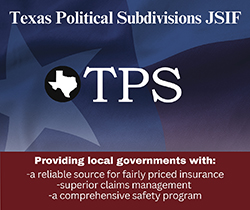Legal document…approved expenditures…statement of revenue…expenses and fund balances.
While these somewhat clinical descriptions of the county budget are certainly valid, the budget document embodies much more to commissioners courts and the constituents they serve. The facts and figures in the Texas county budget often epitomize a way of life, or at least an intended way of life, if budget planners have their say. For example, consider the following defining phrases used in a training session on the county budget:
A plan of action for the fiscal year
A policy statement by the commissioners court
A vision statement for the county
The Gregg County FY 2013 Adopted Budget includes the following explanation:
As in most Texas counties, the annual budget process is the core planning process for Gregg County. Planning processes for budget operations continue year-round in the form of five-year plans, capital needs assessments, and debt reduction plans. Five-Year Plan. The five-year plan process actually consists of 11 years of revenue, expenditure, and fund balance data for the operating and debt service funds. Five years of actual historical data and the current amended budget form the basis for calculating scenarios for the next five years. Graphs are created to provide visual insight, showing ‘where we’ve been, where we are and where we are going’, assuming the same financial management patterns are continued.
Gregg County launches their formal budget process in April with the formulation of the budget instruction manual, which includes the budget calendar for the year and serves as a guide to department officials.
County Progress asked members of the County Judges and Commissioners Association of Texas (CJCAT) leadership team to explain how they approach the often-arduous task of setting the county budget.
Johnson County Judge Roger
Harmon
CJCAT President
Each budget year we send out a request to all elected officials and department heads to send in their budget request. We provide them with a summary of what their budget was last year and also a summary of their actual budget amount spent in the last two years. The request goes to our budget coordinator, who works in my office. When all budgets have been submitted, I set up a specially called commissioners court meeting, and we go over all of the budget requests. When we get our tax rolls in late July, we then have another meeting to see what we can fund and what we cannot fund. The greatest challenge is having enough revenue to fund everyone’s request.
Lubbock County Commissioner Patti Jones
CJCAT First Vice President
In a legislative year we watch legislation to see how it might affect our county as far as fees and existing grants. We also watch for unfunded mandates. Even though the Legislative Budget Board may indicate there will no fiscal impact on the state, they don’t seem to calculate for us on the local level. We also ask our department heads and other elected officials to submit a realistic budget, not one that is inflated. Over the years they have done that, and we have been able to fund most of their requests. The greatest challenge is prioritizing the many requests we receive so we can fund as many as possible.
Brooks County Judge
Raul Ramirez
CJCAT Second Vice President
We consider revenues versus expenses in last year’s budget and previous budgets. We then make adjustments or cuts to our county budget. Brooks County is primarily dependent on oil and gas values. Our greatest challenge is the tax rate, as values have steadily declined every year since 2007. The reality is, it takes more money to operate while less money is coming in.
Hays County
Commissioner
Debbie Gonzales Ingalsbe
CJCAT Immediate Past President
When developing the budget I keep in mind the overall needs of our county plus the needs of our employees to provide great and efficient service; however, most importantly, I consider our citizens’ ability to pay their taxes. These are hard-working individuals whose goal is to provide the best for their families. We also need to consider our large number of retirees who are on a fixed income. The greatest challenge is providing all the services that our citizens want and expect while maintaining a low tax rate.
Calhoun County Commissioner
Neil E. Fritsch
President, South Texas Regional
Association
In Calhoun County all departments send to the county judge and the county auditor a line-item budget that we believe is needed for the coming year. We then meet with all the departments that wish to explain why they need the additional monies, or ones that just wish to meet to discuss items that may affect the budget. We then prioritize the needs of the county departments and decide how the funding will be distributed according to the amount of anticipated revenue.
Probably the greatest challenge the last several years is to find the balance to continue the needed services that people deserve and expect; maintain our infrastructure (roads, bridges, buildings, etc.); provide and plan for expanded growth; and provide decent wages and benefits for our employees. It is a real challenge to execute when you factor in the increased cost of living, while at the same time your revenue is shrinking or stagnate.
Budgeting Handbook
Regardless of individual internal procedures, every county must meet the following standards, according to the Office of the Texas Comptroller:
A. An annual operating budget shall be prepared and adopted for each fiscal year to authorize and control the financial operations of the county government.
B. A budget is the authority for financial operations and a plan that embodies an estimate of proposed expenditures for the coming fiscal year and the proposed means of financing those expenditures. The adopted budget should be integrated with the county’s accounting system to provide a workable system of budgetary accounting and control.
C. The budget should be formulated based on actual and anticipated revenues and other financial resources estimated to be available as provided by law on the last day of each fiscal year to fund the proposed budget for the following fiscal year.
D. The annual operating budget prepared by each county shall provide sufficient information to enable taxpayers and security investors to make informed judgments about the county government’s anticipated financial position and flow of financial resources.
E. To accomplish this, the annual budget shall contain, at a minimum, the following components:
a. A Statement of Indebtedness effective the beginning of the new fiscal year.
b. A Statement of Actual Assessed Property Valuations and Tax Rates.
c. A Tax Collection History for Current and Delinquent Taxes and also Penalties and Interest.
d. A Combined Statement of Financial Position (Cash and/or Fund Balance) including beginning balance, revenues, expenditures, transfers (±) and ending balance.
e. A Recapitulation of the Budget by Fund including anticipated revenues, expenditures, and fund balances.
f. Budget Detail by Fund including a summary of cash and/or fund balance position and detailed revenues and expenditures.
g. Budget Detail by Fund including revenues and expenditures depicting the level of budgetary control.
Step-by-step details including additional statutory requirements such as information on required public hearings can be found in the comptroller’s Budgeting Handbook for Texas Counties 2011 available at http://texasahead.org/lga/finances/budgeting/county_budget/96-853TXCountyBudgetingHandbook.pdf.















